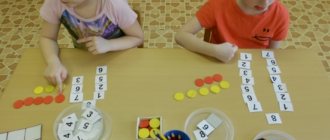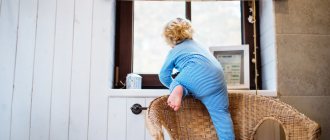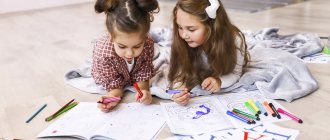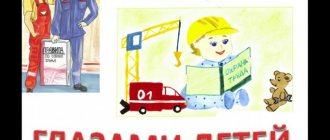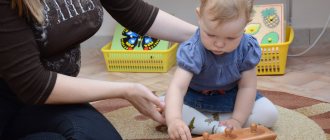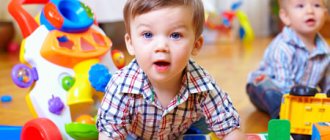At three years old, a child should have learned basic concepts, thanks to which the basic foundation for his intellectual development will be laid. Usually, parents prefer to conduct such classes at home, in a calm environment (since often a three-year-old child has some fear of society and peers: in group classes, many kids look at each other, ready to correct even the correct answer if it differs from someone else’s). What activities should you conduct with three-year-old children?
Classes with a 3-year-old child are an exciting activity: learning colors
Mathematical
What should a child learn?
- Count to five.
- Knowledge of a small number of geometric shapes.
- Basic comparison skills.
- The right pairing.
Remember that at three years old children do not have a long fixation on one subject, so classes must be conducted often and little by little (it is better to conduct three classes for 20 minutes than one for an hour).
Learning shapes from drawings
Developmental activities may include the use of cards, puzzles, copybooks and creative tasks.
Cards
At three years old, your baby can still chew paper, so take the time to laminate the cards so that you don’t have to print out a new set for each lesson. Typically, educational games with children are carried out according to the following scheme: You show the child a card with some image (for children it is better to choose the simplest and most understandable drawings) and ask them to repeat the drawing, or to say how many objects are shown in the picture. If you have a set of paired cards, then you can ask the children to play memory-developing games: “find the pair”, “remember the hidden image”, “find the difference” and so on.
Working with cards solves several problems at once
Remember that such activities can be carried out not only at home, but also on the street.
For example, in the warm season, you can make a treasure hunt game: give your child a real pirate map (with the help of ordinary coffee, the paper can be aged for several years), on which educational cards will be indicated with crosses. Explain to your child that he needs to solve the problem in order to be able to move on.
If you have several children, then you can hold a real competition (remember that each of the children should receive their own incentive prize).
If it is cold outside, then a similar competition can be held at home, having previously hidden all fragile objects.
Puzzles
For three-year-old children, it is best to select large pictures consisting of a small number of details.
Educational puzzles for little ones “Farm”
Cut the educational pictures into vertical lines (they should be quite large). The essence of the lesson is for the child to assemble a puzzle and at the same time learn the name, appearance and location of the number on the number line.
Copybooks
This material will help kids develop their hands, as well as write numbers correctly, freely composing numbers from them. Select the copybooks so that the lines in them are large enough and clear.
Coloring pages
Coloring pages with numbers can be given to children from the age of 3.
They are especially loved by children, so try to use these educational materials as often as possible. Due to their compactness, coloring books can be used both at home and outdoors at any time of the year. For three-year-old children, try to choose coloring books that use not only the image of a number, but also its written name (this will help train reading and speech).
Sensory
It makes me happy when I hit a point of interest and the child gets carried away for a long time and tries something. So recently I noticed her craving for construction, and we purchased a magnetic construction set. I spent the whole day building it and couldn’t tear it away.
Developmental activities with sensory materials are very useful from the age of 3 years. They influence fine motor skills and indirectly prepare for writing and mathematics, as well as geometry and creativity. I made several sets with my own hands.
Noise cylinders. I made sound bottles from packages from Imunele - I simply poured beans, buckwheat and semolina into them. It is better to take cereals of different sizes.
Mysterious bag. You need to put objects of different shapes or textures into an opaque bag. The older the child, the less different they should feel to the touch. To complicate the game, you can add a second bag with the same contents. Ask them to find the same objects with different hands.
Paired color cards. A game-exercise on knowledge of colors and all shades. It starts with three basic colors and gradually increases in complexity to seven shades of each color: from the brightest to the palest. I want to get cards from the paint store so I can line up the colors.
We also arrange the chocolate egg fixies according to height. Or while walking in the forest we look for thick and thin trunks.
We have 2 rooms in our apartment: a kitchen-living room and a bedroom. In the living room there is a separate children's bookcase and a shelf for books. I change the materials from time to time, so this is once a creativity zone, once a music and sensory zone, but a set for caring for plants and a jug of water are always in their place. Nearby there is a workplace consisting of a table with a chair and a shelf for books.
brain teaser
What should a child learn?
- Finding and justifying errors.
- Finding similarities and differences.
- Memorizing words and pictures.
- Concentration of attention.
The latter is especially important: classes with many three-year-old children are complicated by the fact that the child needs a lot of physical activity, and if it is not given, the baby shows his dissatisfaction in the form of crying and hysterics. That is why plan your classes wisely: no more than 20 minutes, and 10 minutes after the start of the class it is recommended to do a short physical exercise minute.
Game activities can be done anywhere
If you study at home, you can, as a reward for active work, go for a walk with your offspring wherever he wants.
Play with your child in associations and opposites as often as possible (this way, reaction speed, verbal and logical thinking are trained). Fairy tales are especially relevant for three-year-old children, so tell a fairy tale with a small mistake that needs to be corrected (for example, the time of year is summer, and the narrator says: “today we went sledding”).
Outdoor games can be educational
If you study at home, give your child several cards with different objects, offering to add the missing ones - this way you will further develop the children’s imagination.
Housework
It's amazing how much children enjoy doing household chores on their own. At home, tables and chairs were washed, laundry could not be done without a child, and vegetables and dishes were washed only in the sink on the assistant’s tower.
It’s even more amazing how ordinary household chores contribute to the development of a 3-4 year old child:
- the child masters specific everyday skills;
- learns to achieve results;
- feels satisfaction and success, self-confidence;
- learns to concentrate;
- refines movements;
- feels independent and self-reliant;
- forms will through choice;
- masters internal algorithms of activity;
- forms the primary everyday logic, which then forms the basis of any other logic;
- the basis is being prepared for a deeper knowledge of writing, creativity, reading and mathematics;
- feels the limits of his capabilities;
- self-control is formed and the level of aggression decreases.
A separate big task was to arrange a home space for this to make it safe and comfortable. At first there was frustration: where to place it. Then inspiration came and decluttering began - what was unnecessary was sold or thrown away, and a place was found for what was needed. It became more comfortable.
There is still a lot to be done, but I am already seeing the fruits and realizing the importance of including my daughter in my life.
We often cook different dishes together.
Porridge in a slow cooker. I put the measured amount of cereal, salt, sugar, milk, and Yulia mixes and turns on the device.
Salads. She washes vegetables herself, learns to peel, cuts with both a wavy and sharp knife, and an apple slicer. Stirs, adds sauces, spices.
Baked goods - pancakes, pancakes, cheesecakes, muffins, pies, pizzas. Kneads the dough, rolls it out, puts it in molds or cuts out figures, and puts in the filling. I bake or fry.
Meat dishes. Beats the meat and sprinkles with spices.
When we cook, we watch videos on YouTube and do it step by step. I want to try to sketch out a recipe together, and then have her cook according to it.
The child has his own shelf in the kitchen. It contains: dishes, cutlery, cutting boards, knives, graters for cooking, a set for washing vegetables and fruits. An apron hangs on the left, and a dustpan and brush hang on the right to sweep away crumbs from the table.
I made several sets to make it easier for the child to learn new skills.
Polishing. First I suggested polishing the wooden elephant. Julia had not yet finished polishing the entire elephant and was not distracted even once, she was so focused. Then I replaced the elephant with a wooden bowl.
Plant care. I moved the only available flower lower so that my daughter could check if it was time to care for it. I trim the dry leaves myself, but she likes to water and wipe the healthy ones. But the main highlight of the set is the watering can.
Flower arrangement. One day, while walking, we picked flowers and blades of grass, collected autumn leaves and made a bouquet using existing bowls, scissors and a jug.
Ironing. I placed everything I needed in the pantry and made a shelf at a level convenient for the child.
Mopping the floor and sweeping up debris, sweeping up dust. I also placed the necessary tools in the pantry.
Washing dishes. If we cook together, then we wash it together under the tap. To do this, I bought a dishwashing brush and a small dispenser, baby dishwashing detergent.
I myself want to take care of the environment with these materials, it turned out so beautifully. I realized how important details and natural materials are. I would never have thought that I would do decoupage and enjoy the process.
Speech
What should a child learn?
- Sentences must be at least 5-6 words.
- The child must be able to name his personal information.
- Clearly distinguishing the characteristics of an object.
- Knowledge of several actions (walks, cries, talks, meows, etc.).
Speech lesson in front of a mirror
If you practice at home, prepare cubes or cards with letters so that your baby continues to form words from them. Remember that three-year-old children still do not have very well developed memory, so do not ask your child to spell out complex words or repeat long sentences
Independence, self-care skills
Young children are not yet able to take care of themselves completely, but by the age of three, the child should already have some self-service skills:
- undress and dress with little assistance;
- put on shoes or at least try to put on shoes on your own;
- wash your face and brush your teeth;
- use cutlery;
- fulfill simple everyday requests: put away toys, put things in their place, put a cup on the table.
Household
What should a child learn?
- Putting on clothes independently.
- Cutting out pictures.
- Coloring pictures.
- Knowledge of basic rules of accuracy.
At 3 years old, a child needs to be taught self-care.
If classes are held at home, then hang posters with hygiene rules throughout the apartment - when passing by them, the child will subconsciously remember them (remember that a child of three years old can be taught very quickly, but a teenager of 16-17 years old nothing can be taught anymore).
Also strive to develop creativity in your son or daughter: at least once every 2-3 months, organize themed parties, for which you can prepare costumes, decorations, scripts and even simple dishes.
In this way, you will gradually encourage your baby to live independently, developing creativity in the meantime.
If you don’t have enough time to carry out such events, then try to at least sometimes prepare crafts from ordinary household items: birds from cups, houses from boxes, and so on.
Hide and seek
Brain development occurs through movement. It is important for a child to move in space. This is how he masters in practice the concepts of “higher”, “lower”, “closer”, “further”, “to the right”, “to the left”. And the easiest way to understand this is through your own body.
www.rastishka.ru
- Why you need to play hide and seek with children: games for kids 2-3 years old
Cognitive
What should a child learn?
- Names of several animals.
- Names of various plants.
- The difference between vegetables and fruits, berries and mushrooms.
- Knowledge of basic natural phenomena.
- Knowledge of the seasons and days.
Classes with cereals teach accuracy.
Prepare cards in advance with images of various birds, animals and plants. At the same time, try to choose those creatures that are found specifically in your city, so that during a walk you can show your child a bird or animal and tell something interesting about them (do not try to load your child with incomprehensible and complex facts, instead telling interesting stories and stories).
Crisis of three years
The three-year crisis is considered the most turbulent in a child’s development, and it is a serious obstacle to regular developmental activities. Negativism, hysterics, stubbornness, ignoring requests, jealousy - you can encounter all this at any time. What to do in this case?
- Change your tactics and ignore the hysteria.
- Give your child more time to recover.
- Provide choice, or the illusion of it.
- Instead of forcing your child, offer help.
- Don't criticize or scold.
If you feel that you cannot cope with yourself and your child, seek the help of child psychologists and early development teachers. Most likely, in an unfamiliar environment the child will begin to behave more calmly. Classes in early development centers are held in small groups of up to 6 people, where children feel comfortable and receive a lot of attention.
Date of publication: 09/24/2018. Last modified: 01/13/2020.
Sports
Physical development is as important for a baby as intellectual development. This is due to the fact that when the child goes to school, he will not only have physical education lessons, in which he must complete all the tasks for agility, strength and endurance, but also outdoor games with classmates during breaks. if for some reason the child is unable to take part in them, then the number of his possible friends risks being reduced.
Every morning, start with simple exercises, including exercises to warm up your muscles, stretching and the obligatory light jogging.
Kids love sports activities very much.
If you have a daughter, then include a variety of dances in the program - usually little ones like them, while boys prefer ball games and jumping.
Be sure to use exercise equipment: jump ropes, a variety of balls, children's dumbbells, bright hoops and gymnastic mats - all this will help the child perform the exercise with greater quality and pleasure, while reducing the risk of injury.
leave a comment
Speech development
Normally, a three-year-old child speaks about 1000 words well and can already speak well, so special attention should be paid to speech development. What can you do?
- Communicate with your child as much as possible, be interested in what he says.
- Perform articulation exercises daily. This will help you place the speech sounds correctly.
- Discuss the story pictures. A collection of fairy tales by Vladimir Suteev is ideal for classes.
- Learn poems and songs. Poetic riddles are a hit with kids.
Speech development is positively influenced by games and exercises that involve fine motor skills , for example:
- all kinds of games with cereals, beans, buttons, sand, shells, pasta, etc.;
- fastening buttons, lacing;
- finger gymnastics;
- origami;
- games with water.
Musical activities help develop speech hearing: singing, guessing familiar sounds, playing musical instruments, guessing songs, singing vowel sounds.
Daily routine and care for a three-year-old child
The baby becomes very active, and it is important to adhere to a daily routine so that the child has enough strength. Of course, the routine of a child who goes to kindergarten will differ from the routine of a child who does not attend preschool, but an approximate daily routine for three-year-olds could be like this:
| 07.00 | Climb |
| 07.30 | Hygiene procedures, exercise |
| 08.00 | Breakfast |
| 08.30 | Educational games and activities, help with everyday life |
| 10.00 | Walk |
| 12.00 | Dinner |
| 12.30 | Daytime nap |
| 15.00 | Awakening |
| 15.30 | Afternoon snack |
| 16.00 | Outdoor and educational games |
| 18.00 | Walk |
| 19.00 | Dinner |
| 19.30 | Quiet activities |
| 20.30 | Hygiene procedures |
| 21.00 | Night sleep |
⠀
